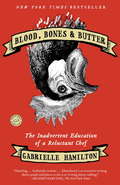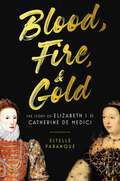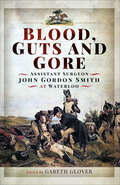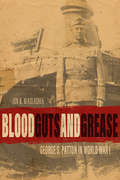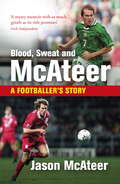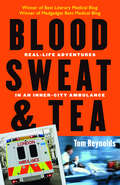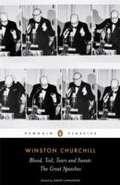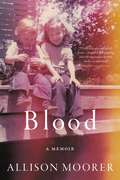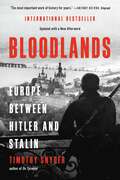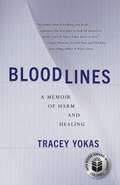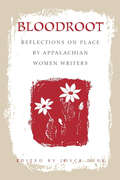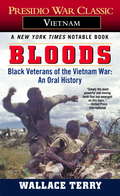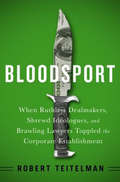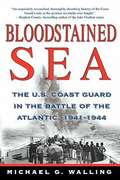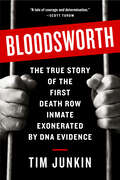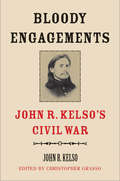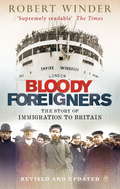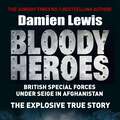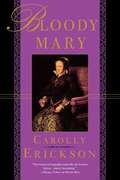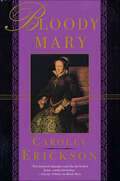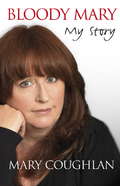- Table View
- List View
Blood, Bones & Butter: The Inadvertent Education of a Reluctant Chef
by Gabrielle HamiltonNEW YORK TIMES BESTSELLER. Before Gabrielle Hamilton opened her acclaimed New York restaurant Prune, she spent twenty hard-living years trying to find purpose and meaning in her life. Blood, Bones & Butter follows an unconventional journey through the many kitchens Hamilton has inhabited through the years: the rural kitchen of her childhood, where her adored mother stood over the six-burner with an oily wooden spoon in hand; the kitchens of France, Greece, and Turkey, where she was often fed by complete strangers and learned the essence of hospitality; Hamilton's own kitchen at Prune, with its many unexpected challenges; and the kitchen of her Italian mother-in-law, who serves as the link between Hamilton's idyllic past and her own future family--the result of a prickly marriage that nonetheless yields lasting dividends. By turns epic and intimate, Gabrielle Hamilton's story is told with uncommon honesty, grit, humor, and passion. Look for special features inside.
Blood, Fire & Gold: The Story of Elizabeth I & Catherine de Medici
by Estelle Paranque**SMITHSONIAN MAGAZINE, "10 BEST HISTORY BOOKS OF 2022"** **HISTORY TODAY, "BOOKS OF THE YEAR (2022)"**A brilliant and beautifully written deep dive into the complicated relationship between Elizabeth I and Catherine de Medici, two of the most powerful women in Renaissance Europe who shaped each other as profoundly as they shaped the course of history. Sixteenth-century Europe was a hostile world dominated by court politics and patriarchal structures, and yet against all odds, two women rose to power: Elizabeth I and Catherine de Medici. One a young Virgin Queen who ruled her kingdom alone, and the other a more experienced and clandestine leader who used her children to shape the dynasties of Europe, much has been written about these shrewd and strategic sovereigns. But though their individual legacies have been heavily scrutinized, nothing has been said of their complicated relationship—thirty years of camaraderie, competition, and conflict that forever changed the face of Europe. In Blood, Fire, and Gold, historian Estelle Paranque offers a new way of looking at two of history's most powerful women: through the eyes of the other. Drawing on their private correspondence and brand-new research, Paranque shows how Elizabeth and Catherine navigated through uncharted waters that both united and divided their kingdoms, maneuvering between opposing political, religious, and social objectives—all while maintaining unprecedented power over their respective domains. Though different in myriad ways, their fates and lives remained intertwined of the course of three decades, even as the European geo-politics repeatedly set them against one another. Whether engaged in bloody battles or peaceful accords, Elizabeth and Catherine admired the force and resilience of the other, while never forgetting that they were, first and foremost, each other's true rival. This is a story of two remarkable visionaries: a story of blood, fire, and gold. It is also a tale of ceaseless calculation, of love and rivalry, of war and wisdom, and—above all else—of the courage and sacrifice it takes to secure and sustain power as a woman in a male-dominated world. A Times' "Book of the Week"
Blood, Guts and Gore: Assistant Surgeon John Gordon Smith at Waterloo
by John Gordon SmithJohn Gordon Smith wrote one of the most vivid, honest and readable personal accounts of the Battle of Waterloo and the ensuing campaign, where he served as a surgeon in the12th Light Dragoons, but his classic narrative was only published in a limited edition in the 1830s and since then it has been virtually unknown. His warts-and-all depiction of the British army in Belgium and France and the fighting at Waterloo rivals many of the more famous and often reprinted military memoirs of the period. That is why Gareth Glover, one of the foremost experts on the battle and the archive sources relating to it, has sought to republish the narrative now, with a full introduction and explanatory notes. Smith’s account reads like a novel, in a chatty, easy-going style, but it often records deeply shocking scenes and behaviour so scandalous that he had to avoid naming names. As well as recalling, in graphic detail, his experience as a medic during the battle, he records the aftermath, the allied occupation of France. His writing, which describes the truly dreadful consequences of the fighting as only a surgeon would see them, also gives the reader a rare insight into his role and a memorable impression of the life in the army as a whole.
Blood, Guts, and Grease: George S. Patton in World War I (American Warriors Series)
by Jon B. Mikolashek&“Sheds light on the complex personality that has been, in many ways, masked by the legend that emerged during World War II and has grown since.&” —Col. Gregory Fontenot, ARMY Magazine George S. Patton is one of the most controversial, celebrated, and popular military leaders in American history, and his accomplishments and victories have been greatly documented. Yet Patton spent years in the Army before garnering national attention and becoming a highly-regarded and respected military leader. Drawing upon Patton&’s papers and archival documents in the National Archives, this is an early-career biography of the eminent military leader. It begins with his exploits as a relatively junior but ambitious Army officer who, due to his family&’s wealth and influence, was able to join General John J. Pershing&’s American Expeditionary Force (AEF). This assignment would ultimately change his life in two ways: it would make Pershing the mentor Patton would emulate for the rest of his life, and it would catapult his military career as the first tanker in the US Army. This study follows Patton&’s trajectory, from the creation of the Tank Corps and the Light Tank School, to Patton&’s eventual successes and injuries during the Battle of Saint Mihiel, the attack into Pannes, and the Meuse-Argonne Offensive. The experience Patton gained in World War I was seminal in his evolvement as a leader and laid the groundwork for not only his own personal future triumphs but also for the success of the entire U.S. Army armored forces in World War II. &“No one can really understand the Patton of World War II until they know about the man who fought through the First World War.&” —Thomas Bruscino, US Army War College
Blood, Sweat and McAteer: A Footballer's Story
by Jason McAteerFormer Republic of Ireland and Premier League footballer Jason McAteer shares the highs and lows from his long and colourful career ...The fighting McAteers: that's how the McAteer family of title-winning boxers were known throughout Birkenhead, across the Mersey from Liverpool. But for eleven-year-old Jason McAteer, growing up in the shadow of Liverpool FC, football became the dream. After signing with Bolton Wanderers at the age of twenty-one, the call to the international scene followed with the Republic of Ireland and, soon after, to his beloved Liverpool FC. The dream had become a reality. From his time with the Irish World Cup squad of 1994 to those tumultuous days in Saipan in 2002; on through his decision to leave Liverpool for Blackburn Rovers; his move to Sunderland, and the depression he fell into after finishing his professional career with Tranmere Rovers, Jason McAteer looks back with characteristic honesty and humour on his life - the jokes, the matches, and the personalities.This is the real Jason McAteer: a little bit bruised, a little bit battered. But still fighting.
Blood, Sweat, & Tea: Real-Life Adventures in an Inner-City Ambulance
by Tom ReynoldsA collection of true life stories from “one of the most gripping blogs around” recounting life as a paramedic for a British ambulance service. (The Guardian)Have you ever wondered what's going on inside the ambulance screaming past you during your rush-hour commute? Since 2003, Tom Reynolds (writing under an alias so as not to get sacked from his job), has kept a blog where he chronicles the day-in, day-out realities of his life on the job as an EMT with the London Ambulance Service. By turns both poignant and profound, Reynolds's writing captures the very essence of life and death. From the mundane to the surreal, from the heartwarming to the cynical, from the calm to the frenetic, more than 300 entries from his award-winning blog, Random Acts of Reality (randomreality.blogware.com) are included in the book. The tales are the stuff of Grey's Anatomy, House, and ER—only these events aren't unfolding on a Hollywood soundstage but on the front lines of a first responder’s real life.“An alluring mix of humor, bravery, cynicism, and compassion.” —London Daily Telegraph
Blood, Toil, Tears and Sweat: The Great Speeches
by Winston Churchill David CannadineThe collected speeches of the most eloquent and expressive statesman of his time. The only political leader to win the Nobel Prize in Literature, Winston Churchill used language as a weapon at a time when he possessed nothing more than an empty armory with which to fight his nation's enemies. <P><P>In this major volume, David Cannadine one of the foremost historians of modern Britain selects thirty-three speeches ranging over fifty years, demonstrating how Churchill honed his rhetoric until the day when, in the words of Edward R. Murrow, he mobilized the English language, and sent it into battle. A landmark of political speech making, perfect for the election year, Blood, Toil, Tears and Sweat is an essential addition to the library of every Churchill fan.
Blood: A Memoir
by Allison MoorerThe Grammy- and Academy Award- nominated singer-songwriter's haunting, lyrical memoir, sharing the story of an unthinkable act of violence and ultimate healing through artMobile, Alabama, 1986. A fourteen-year-old girl is awakened by the unmistakable sound of gunfire. On the front lawn, her father has shot and killed her mother before turning the gun on himself. Allison Moorer would grow up to be an award-winning musician, with her songs likened to "a Southern accent: eight miles an hour, deliberate, and very dangerous to underestimate" (Rolling Stone). But that moment, which forever altered her own life and that of her older sister, Shelby, has never been far from her thoughts. Now, in her journey to understand the unthinkable, to parse the unknowable, Allison uses her lyrical storytelling powers to lay bare the memories and impressions that make a family, and that tear a family apart.Blood delves into the meaning of inheritance and destiny, shame and trauma -- and how it is possible to carve out a safe place in the world despite it all. With a foreword by Allison's sister, Grammy winner Shelby Lynne, Blood reads like an intimate journal: vivid, haunting, and ultimately life-affirming.
Bloodlands: Europe Between Hitler and Stalin
by Timothy SnyderAmericans think of World War II as "The Good War. ” But before it even began, America’s ally Stalin had shot and starved millions of his own citizens; he would continue to do so throughout the war. American soldiers liberated concentration camps, but they never reached the death factories, killing fields, and starvation sites in the East where Hitler and Stalin murdered civilians on a massive scale. In twelve years, in deliberate killing policies unrelated to combat, the Nazi and Soviet regimes killed fourteen million people in a zone of death between Berlin and Moscow. At war’s end, these bloodlands fell behind the iron curtain, leaving their history in darkness. In Bloodlands, acclaimed historian Timothy Snyder offers a groundbreaking investigation of the place where Europeans were murdered by the millions, providing a fresh account of the atrocities perpetrated by the two regimes. Assiduously researched, deeply humane, and utterly definitive, Bloodlands is required reading for anyone seeking to understand the central tragedy of modern history.
Bloodlands: Europe Between Hitler and Stalin
by Timothy SnyderFrom the best-selling author of On Tyranny comes the definitive history of Hitler's and Stalin's wars against the civilians of Europe in World War II. <p><p> Americans call the Second World War "The Good War." But before it even began, America's wartime ally Josef Stalin had killed millions of his own citizens - and kept killing them during and after the war. Before Hitler was finally defeated, he had murdered six million Jews and nearly as many other Europeans. At war's end, both the German and the Soviet killing sites fell behind the iron curtain, leaving the history of mass killing in darkness. <p><p> Bloodlands is a new kind of European history, presenting the mass murders committed by the Nazi and Stalinist regimes as two aspects of a single history, in the time and place where they occurred: between Germany and Russia, when Hitler and Stalin both held power. Assiduously researched, deeply humane, and utterly definitive, Bloodlands will be required listening for anyone seeking to understand the central tragedy of modern history. <p><P> Bloodlands won 12 awards including the Emerson Prize in the Humanities, a Literature Award from the American Academy of Arts and Letters, the Leipzig Award for European Understanding, and the Hannah Arendt Prize in Political Thought. It has been translated into more than 30 languages, was named to 12 book-of-the-year lists, and was a best seller in six countries. <p> <b>New York Times Bestseller</b>
Bloodletting: A Memoir of Secrets, Self-harm, and Survival
by Victoria LeathamOn the Outside, Victoria Leatham appears to have it all. She's creative, beautiful, confident. But inside she struggles with silent, secret, and unbearable pain. In her late teens, Leatham is struck with an undeniable urge to cut herself. Oddly, the wounds she inflicts on herself mute the pain she feels inside. This memoir, a darkly humorous and often chilling account, vividly details Leatham's ordeal and reveals her most intimate thoughts as she struggles with cutting and a range of other psychological problems including eating disorders, sexual promiscuity, substance abuse, and bipolar disorder. And finally, it describes her discovery of the psychological secret that helps her escape from this spiral of self-destruction.
Bloodlines: A Memoir of Harm and Healing
by Tracey YokasIt should have been Tracey Yokas&’s time to heal. With the recent death of her mother, she was given a brand-new chance to redefine herself and her happiness on her own terms. But just as she prepares herself to spread her wings, Tracey discovers that her only child, Faith, is battling issues of her own—carrying forward the legacy of disordered eating, depression, and self-harm Tracey is so desperate to leave behind. Tracey is determined to save her daughter, but she has no idea how to reach her—and as their fragile family navigates a medical system and a societal fabric that fails innumerable families in need, she and Faith become near strangers to each other. Ultimately, it&’s only when Tracey begins the hard work of standing up to her own history of rejection, low self-esteem, and longing does healing—for both mother and daughter—become possible.Carrying a message made urgent by the epidemic of mental health challenges now besetting millions of American teens each year, Bloodlines is a story about how waking up to the power of love can allow us to reimagine the past—and fortify the present.
Bloodlines: Odyssey of a Native Daughter
by Janet Campbell HaleA collection of essays--on writing, American Indian reservation life, being a woman, and family--by a distinguished writer and member of the Coeur d'Alene tribe. In haunting prose, Hale interweaves her own experiences with striking portraits of relatives into a rich tapestry of history, storytelling, and remembrance.
Bloodroot: Reflections on Place by Appalachian Women Writers
by Joyce Dyer“A broad sampling of deeply impressive writings—essays, memoirs, poetry, letters, stories—by women from the Southern Highlands.” —Kirkus ReviewsWinner of the 1997 Appalachian Studies Award Appalachian Writers Association 1999 Book of the Year Winner of the Susan Koppleman Award of the Popular Culture Association for Best Edited Collection in Women’s Studies Thirty-five women writers from Appalachia define the region in a larger, more generous, and more intricate way that it has been defined before, dispelling many demeaning stereotypes of the region. The writers tell their compelling stories with poignancy, eloquence, forthrightness, and humor. A new American literary renaissance is ablaze in the Southern Highlands—the very place so often depicted by outsiders as dimly lit. 35 photos.“Dyer succeeds admirably in a dual purpose: to promote a vital and virtually unknown body of work, and to suggest an Appalachian spirit that transcends state borders and artistic genres.” —Publishers Weekly (starred review)“From the well-known, like Dykeman, Sharyn McCrumb and Denise Giardina, to the lesser known, these essayists, in one way or another, write of what it means to come to fully appreciate one’s native tongue; to be inspired by the courage and fortitude of their Appalachian foremothers; and to glory in their profound attachment to the natural beauty of the Appalachian hills, hollers and trails.” —Bowling Green Daily News“The writers here represent some of the most unique and often unsung talent in literature. These essays will carry you to a far mountain place and whet your appetite for more.” —Magazine (Baton Rouge, LA)
Bloods
by Wallace Terry"Simply the most powerful and moving book that has emerged on this topic." UNITED PRESS INTERNATIONALThe national bestseller that tells the truth of about Vietnam from the black soldiers' perspective. An oral history unlike any other, BLOODS features twenty black men who tell the story of how members of their race were sent off in disproportionate numbers and the special test of patriotism they faced. Told in voices no reader will soon forget, BLOODS is a must-read for anyone who wants to put the Vietnam experience in historical, cultural, and political perspective.Cited by THE NEW YORK TIMES as One of the Notable Books of the Year"Superb."TIME
Bloodsport: When Ruthless Dealmakers, Shrewd Ideologues, And Brawling Lawyers Toppled The Corporate Establishment
by Robert TeitelmanThe epic battle of the fascinating, flawed figures behind America’s deal culture and their fight over who controls and who benefits from the immense wealth of American corporations. Bloodsport is the story of how the mania for corporate deals and mergers all began. The riveting tale of how power lawyers Joe Flom and Marty Lipton, major Wall Street players Felix Rohatyn and Bruce Wasserstein, prominent jurists, and shrewd ideologues in academic garb provided the intellectual firepower, creativity, and energy that drove the corporate elite into a less cozy, Hobbesian world. With total dollar volume in the trillions, the zeal for the deal continues unabated to this day. Underpinning this explosion in mergers and acquisitions--including hostile takeovers--are four questions that radically disrupted corporate ownership in the 1970s, whose force remains undiminished: Are shareholders the sole "owners” of corporations and the legitimate source of power? Should control be exercised by autonomous CEOs or is their assumption of power illegitimate and inefficient? Is the primary purpose of the corporation to generate jobs and create prosperity for the masses and the nation? Or is it simply to maximize the wealth of shareholders? This battle of ideas became the "bloodsport” of American business. It set in motion the deal-making culture that led to the financialization of the economy and it is the backstory to ongoing debates over competitiveness, job losses, inequality, stratospheric executive pay, and who "owns” America’s corporations.
Bloodstained Sea: The U.S. Coast Guard in the Battle of the Atlantic, 1941-1944
by Michael G. WallingThe U.S. Coast Guard, typically pictured as gleaming white vessels dispatched to save mariners in distress, played a vital role during World War II. Called upon in desperate times, the Coast Guard steamed into action and plied the unforgiving waters of the North Atlantic protecting convoys carrying much needed supplies, hunting German U-boats, pulling survivors of destroyed ships from the sea, and helping to ensure that the Atlantic remained in Allied control. The bloody skirmishes, numerous sinkings, and horrific death toll tallied in the Atlantic between 1939 and 1945 became known as the Battle of the Atlantic. Stretching from above the Arctic Circle south to the Cape of Good Hope and west from the coast of England into the Caribbean and down the coast of South America, the Battle of the Atlantic was fought continuously for 2,075 days. Whoever won the battle would control the vast sea-lanes necessary to win the war in Europe. Ships are the only way of moving large amounts of men and material across an ocean, and the United Kingdom, an island nation, needed to import virtually everything to sustain her people. Also, starting in 1941, the large amount of supplies the Soviet Union needed to repel German forces had to be shipped either north from England to Murmansk or around the Cape of Good Hope, then north into the Persian Gulf and overland to Russia. The same route was used to supply British and British Commonwealth troops in Egypt, except that these ships went up the Red Sea and through the Suez Canal.
Bloodsworth: The True Story of the First Death Row Inmate Exonerated by DNA Evidence
by Tim JunkinFans of Serial and Making a Murderer, meet Kirk Bloodsworth, the first death row inmate exonerated by DNA evidence. <P><P> Charged with the rape and murder of a nine-year-old girl in 1984, Bloodsworth was tried, convicted, and sentenced to die in Maryland's gas chamber. From the beginning, he proclaimed his innocence, but when he was granted a new trial because his prosecutors improperly withheld evidence, the second trial also resulted in conviction. <P><P>Bloodsworth read every book on criminal law in the prison library and persuaded a new lawyer to petition for the then-innovative DNA testing. After nine years in one of the harshest prisons in America, Bloodsworth was vindicated by DNA evidence. Intense and hard-hitting, Bloodsworth is the story of a man’s tireless fight against a justice system that failed him.
Bloody Engagements: John R. Kelso's Civil War
by Christopher Grasso John R. KelsoThe first edited edition of a Union soldier’s remarkable memoir, offering a rare perspective on guerrilla warfare and on the larger meanings of the Civil War While tales of Confederate guerilla-outlaws abound, there are few scholarly accounts of the Union men who battled them. This edition of John R. Kelso’s Civil War memoir presents a firsthand account of an ordinary man’s extraordinary battlefield experiences along with his evolving interpretation of what the bloody struggle meant. A former Methodist preacher and Missouri schoolteacher, Kelso served as a Union Army foot soldier, cavalry officer, guerilla fighter, and spy. Initially shaped by a belief in the Founding Fathers’ republic and a disdain for the slave-holding aristocracy, Kelso became driven by revenge after pro-Southern neighbors stole his property, burned down his house, and drove his family and friends from their homes. Interweaving Kelso’s compelling voice with historian Christopher Grasso’s insightful commentary, this fascinating work charts the transformation of an everyday citizen into a man the Union hailed as a hero and Confederate sympathizers called a monster.
Bloody Foreigners: The Story of Immigration to Britain
by Robert WinderImmigration is one of the most important stories of modern British life, yet it has been happening since Caesar first landed in 53 BC. Ever since the first Roman, Saxon, Jute and Dane leaped off a boat we have been a mongrel nation. Our roots are a tangled web. From Huguenot weavers fleeing French Catholic persecution in the 18th century to South African dentists to Indian shopkeepers; from Jews in York in the 12th century (who had to wear a yellow star to distinguish them and who were shamefully expelled by Edward I in 1272) to the Jamaican who came on board the Windrush in 1947. The first Indian MP was elected in 1892, Walter Tull, the first black football player played (for Spurs and Northampton) before WW1 (and died heroically fighting for the allies in the last months of the war); in 1768 there were 20,000 black people in London (out of a population of 600,000 - a similar percentage to today). The 19th century brought huge numbers of Italians, Irish, Jews (from Russia and Poland mainly), Germans and Poles. This book draws all their stories together in a compelling narrative.
Bloody Foreigners: The Story of Immigration to Britain
by Robert WinderImmigration is one of the most important stories of modern British life, yet it has been happening since Caesar first landed in 53 BC. Ever since the first Roman, Saxon, Jute and Dane leaped off a boat we have been a mongrel nation. Our roots are a tangled web. From Huguenot weavers fleeing French Catholic persecution in the 18th century to South African dentists to Indian shopkeepers; from Jews in York in the 12th century (who had to wear a yellow star to distinguish them and who were shamefully expelled by Edward I in 1272) to the Jamaican who came on board the Windrush in 1947. The first Indian MP was elected in 1892, Walter Tull, the first black football player played (for Spurs and Northampton) before WW1 (and died heroically fighting for the allies in the last months of the war); in 1768 there were 20,000 black people in London (out of a population of 600,000 - a similar percentage to today). The 19th century brought huge numbers of Italians, Irish, Jews (from Russia and Poland mainly), Germans and Poles. This book draws all their stories together in a compelling narrative.
Bloody Heroes: BRITISH SPECIAL FORCES UNDER SEIGE IN AFGHANISTAN. THE EXPLOSIVE TRUE STORY.
by Damien LewisThe most explosive true war story of the 21st Century.It is the winter of 2001. A terror ship is bound for Britain carrying a horrifying weapon. The British military sends a crack unit of SAS and SBS to assault the vessel before she reaches London.So begins a true story of explosive action as this band of elite warriors pursues the merchants of death from the high seas to the harsh wildlands of Afghanistan. The hunt culminates in the single greatest battle of the Afghan war, the brutal and bloody siege of an ancient mud-walled fortress crammed full of hundreds of Al-Qaeda and Taliban.Fighting against impossible odds and bitter betrayal, our handful of crack fighters battle to rescue their fellow soldiers trapped by a murderous, fanatical enemy.'The most dramatic story of a secret wartime mission you will ever read' News of the World'The author has been given unprecedented access' Zoo'Gripping' Eye Spy(P)2023 Quercus Editions Limited
Bloody Mary
by Carolly EricksonHere is the tragic, stormy life of Mary Tudor, daughter of Henry VIII and Katherine of Aragon. Her story is a chronicle of courage and faith, betrayal and treachery--set amidst the splendor, pageantry, squalor, and intrigue of sixteenth-century Europe. The history of Mary Tudor is an improbable blend of triumph, humiliation, heartbreak, and devotion--and Ms. Erickson recounts it all against the turbulent background of European politics, war, and religious strife of the mid-1500s. The result is a rare portrait of the times and of a woman elevated to unprecedented power in a world ruled and defined by men.`
Bloody Mary
by Carolly EricksonHere is the tragic, stormy life of Mary Tudor, daughter of Henry VIII and Katherine of Aragon. Her story is a chronicle of courage and faith, betrayal and treachery-set amidst the splendor, pageantry, squalor, and intrigue of sixteenth-century Europe.The history of Mary Tudor is an improbable blend of triumph, humiliation, heartbreak, and devotion-and Ms. Erickson recounts it all against the turbulent background of European politics, war, and religious strife of the mid-1500s. The result is a rare portrait of the times and of a woman elevated to unprecedented power in a world ruled and defined by men.
Bloody Mary: My Story
by Mary CoughlanSince she rose to international fame in 1985 with her seminal Irish jazz album Tired and Emotional, Mary Coughlan's battles with addiction, the problems in her personal life and career have been well documented. But until now she has never spoken of the traumatic events in her childhood that led to a life of rebellion, running away, and reliance on drugs and alcohol.In this funny, moving and typically outspoken memoir, Ireland's best-loved jazz singer pulls no punches in getting to the heart of what made Mary so contrary.Detailing her battles with the bottle, her suicide attempts and her confinement in psychiatric hospitals, Mary tells of how, after hitting rock-bottom, she pulled herself out of the dregs of a vodka bottle to confront the foundations of her problems head-on.As she tells her story - with a ribald, running commentary on the highs and lows of celebrity culture - we get to experience an alternative evolution of Ireland in the '70s and '80s, populated with hippies, rock stars and movie moguls, and one wild Irish girl determined to live a life less ordinary.
